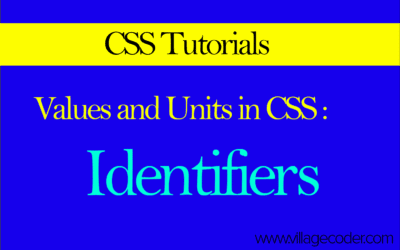Class and ID selectors are used to style elements by using the attributes of the elements.
nanadwumor

RECOMMENDED ARTICLES
identifiers in CSS
The secret power of CSS identifiers, the tiny names that give you full control over your styles! Identifiers are custom CSS names you create. CSS treats similar names with different cases as unique. Used in list counters like...
Images in CSS
Did you know CSS can create images without using a single file? CSS uses URLs to display images. [crayon-68e669d760f17978802738-i/] serves images by device quality. Gradients generate images with colors only. Useful for backgrounds, designs, and...
inherit, initial, unset in CSS
Tiny CSS keywords can reset, copy, or undo styles with just one word. Keywords control styles without numbers inherit copies, initial resets, unset smart reset all applies to most properties, safer to limit revert returns to browser/user defaults...
Class and ID selectors are used to style elements by using the attributes of the elements. Class and ID selectors allow us to target specific parts of the CSS without affecting all the elements.
Class Selectors
Elements can be assigned classes so that the classes be used to select particular elements to style.
|
1 2 3 4 |
<p class="science">The types of sciences include Biology, Physics, Chemistry, Geology. </p> <p class="arts">The types of arts subjects include Government, Geography. <span class="difference">Arts is equally important as Science</span>. We should also note that <span id="science">information technology is also science</span></p> |
The above has two <p> elements. First <p> element is assigned a class of attribute science. The second <p> element has class of attribute arts. The <span> element has the class with attribute difference.
If we want to apply styles to elements using classes, we precede the class with a period (.)
|
1 2 3 4 5 6 7 8 9 10 11 |
.science { color : red; } .arts { color : blue; } .difference{ color : green; } |
The first <p> element will be colored red. The second <p> element will be colored blue. The <span> element will be colored green.
Using class selectors in conjunction with elements
Class selectors can be used with elements. You type the selector, type a period followed by name of the class. The separates the element selector from the class selector. For example,
|
1 2 3 4 |
p.science{ font-wieght : 18px; background-color : yellow; } |
The style will affect not all <p> elements but only <p> elements with the class science. The output will be :
The types of sciences include Biology, Physics, Chemistry, Geology.
The types of arts subjects include Government, Geography. Arts is equally important as Science. We should also note that information technology is also science. In most instances, a general class selector is first applied followed by an element specific class selector to further add specific styles to particular elements. For example,
|
1 2 3 4 5 6 7 |
.science { color : red; } span.science { font-wieght : bold; } |
All elements with the science class are in red. Besides, only span elements with science class are in boldface. Here, we see general style applied followed by specific style for <span> element.
Note the following :
|
1 2 3 |
*. science { color : red; } |
applies to all elements bearing the science class. This will have same effect as writing it without the universal selector. That’s,
|
1 2 3 |
.science { color : red; } |
Just like in programming languages, don’t begin a class name with number in CSS. This will create problem in CSS validation. For example, don’t write
|
1 |
<p class="1700">The year Ashanti Empire was founded is 1700</p> |
Using number to begin class names may be pardoned in HTML but not in CSS. If the user of a number to begin a class becomes a must, precede it with forward slash. That’s,
In a CSS, if you have to deal with a class that begins with a number, use a backslash in between the period and first number. For example,
|
1 2 3 |
.\1700{ font-style : italic; } |
Multiple Classes
Two or more classes can be combined in one rule. For example,
|
1 |
<p class="science arts">Both science and arts are important endeavors</p> |
.science.arts is two combined classes. Elements bearing those classes are boldfaced.
We can also apply two classes to a single element by separating the class values with space. For example,
|
1 2 3 |
.\1700{ font-style : italic; } |
Here, the style of both science and arts are applied to the element.
An element can also be given an id. id is short for Identity. An id is similar to a class. However, id is used to uniquely refer to a particular element only. If you want to apply a particular rule to two or more elements, use a class instead. The analogy is that several elements can be in one class but identity is unique.
For example,
|
1 2 3 4 5 |
<div id="main"> This is the main section. <div id="header"> This is the header.</div> </div> |
If we want to style the <div>with the “header” id, we use
|
1 2 3 4 |
#header{ background-color : blue; color : yellow; } |
For an id, we precede it with the hash or pound sign.
Note :
An id cannot begin with a number. If by any chance, you have to refer to an id in HTML document that begins with a number, use a backslash between the pound sign and the id name. For example,
|
1 2 3 4 5 |
<p id="1700">The Ashanti Empire was founded in 1700</p> #\1700{ font-wieght : bold; } |
When to use class or id
Class is used when we want to apply style to two or more elements. An id is used if we want to apply style to only one element.
Why id selector should be unique
If you have more than one of the same ID value in a document, DOM scripting becomes more difficult. JavaScript function like getElement ById() picks only one unique element with the stated id value.
Combining id selectors
You can combine two id selectors. For example,
|
1 2 3 4 5 6 |
<p id="ashanti">The Ashanti region is the cultural capital of Ghana.</p> <p id="others">The other regions also have their cultures.</p> #ashanti#others { font-style : italic; } |
You cannot use names separated by space for value of id. That’s, the following id value is wrong.
|
1 |
<p id="ashanti empire">The Ashanti Empire was the single resistance force to British colonialism in Africa</p> |
“ashanti empire” is wrong because it’s separated by space. Because space isn’t allowed in id names, two or more IDs cannot be combined to style an element like the way we do with classes.




Recent Comments